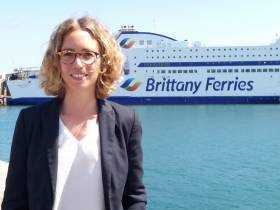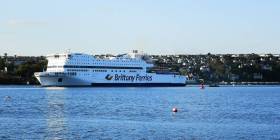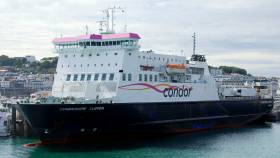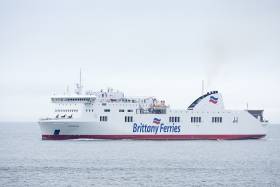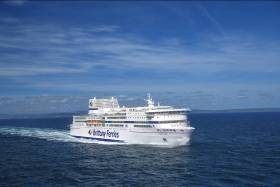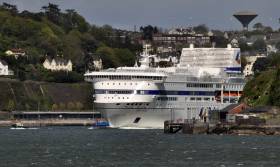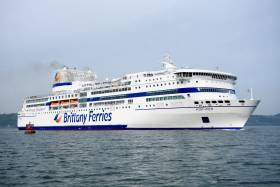Displaying items by tag: Brittany Ferries
Newbuild E-Flexer Pair Mark Double-Celebration for Brittany Ferries
Operator Brittany Ferries has marked two key milestones in its €550 million fleet renewal programme which includes a pair of E-Flexer newbuilds destined for UK-Spain routes.
At the AVIC Weihai shipyard in Shandong, eastern China, shipyard workers and Brittany Ferries teams gathered to celebrate the launch of cruise-ferry Galicia, and the start of building work for sister ship Salamanca.
The 215-metre long hull of Galicia was majestically floated out at a traditional Chinese ship-launching ceremony. Then, alongside in the building dock the very first steel was cut for fleet mate Salamanca marking the beginning of the ship’s construction.
When complete, the two ships will serve Brittany Ferries’ long-haul routes connecting Portsmouth to Santander and Bilbao in northern Spain, with Galicia due to enter service in late 2020 followed by Salamanca in spring 2022. They will be joined a year later by a third sister ship to be named Santoña.
“It gives me great pleasure to be here in China today (11 Sept) to celebrate the launch of Galicia and the start of work on Salamanca,” said Brittany Ferries CEO Christophe Mathieu. “Our customers rightly expect our fleet to be modern, comfortable and efficient, with the promise of minimal environmental impact from operations and we can only achieve this aim with the very best, innovative new ships. Galicia and Salamanca are perfectly suited to our long-haul Spanish operations, and will allow us to further enhance our service to holidaymakers and hauliers taking advantage of these routes.
“As a French company operating ferries between the UK, France, Spain and Ireland, we are, for sure, concerned by the current political uncertainty in Europe. But we are certain of the course that Brittany Ferries will follow in the years to come. And these brand new ships are tangible evidence – in steel – of our confidence and optimism looking ahead”.
The three 42,200-tonne ‘E-Flexer’ class ships will be amongst the biggest in Brittany Ferries’ fleet, measuring 215 metres long, with around three kilometres of space for cars and lorries.
Not only will they be capacious, comfortable and efficient – they’ll also be better for the environment. Whilst Galicia will be fitted with funnel exhaust gas cleaning systems, Salamanca and Santoña will be amongst the first ferries of their type to be powered by Liquefied Natural Gas (LNG) offering significant environmental advantages over traditional marine fuels, burning more efficiently and producing no sulphur, virtually no particulates and 95 per cent less nitrogen dioxide.
The company’s very first LNG-powered ship Honfleur currently under construction in Flensberg, Germany (albeit delayed see story) will enter service on the busy Portsmouth to Caen route in 2020.
Operator Brittany Ferries have formally submitted an offer to buy Condor, the French ferry company’s president has said, reports Jersey Evening Post.
Speaking to French newspaper Ouest-France, Jean-Marc Roué confirmed the news but said he thought that other businesses would also be submitting an offer.
The news follows another report from the same newspaper in June that the French-based shipping company was putting in the offer to counter a ‘rapid-expansion plan’ from one of its competitors, Danish company DFDS.
The article also said that the move would secure vital ports – St Malo, Poole and Portsmouth – from their competitors.
However, it has been rumoured that other carriers, such as Stena and Irish Ferries, could also be interested.
For more on the Channel Islands operator click here.
New Names Announced for Brittany Ferries Expanding Fleet Set to Significantly Reduce CO2
Kerry has been announced as the name of Brittany Ferries ropax vessel that Afloat.ie previously reported is to be introduced in November 2019.
The ship Afloat adds is a Visentini-class designed ropax likewise to the existing Ireland-Spain serving Connemara. Kerry will cover the Cork-Santander route from November 2019 to November 2020.
The company has also revealed that Santoña (a town located in Cantabria and pronounced Santonia in English) has been chosen for the company’s third E-Flexer class ship. To be chartered from Stena, Santoña is part of the company’s €550 million fleet renewal programme, with a clear focus on sustainable development. Santoña will arrive in 2023 and like sister ship Salamanca, she will be powered by environmentally-friendly Liquefied Natural Gas (LNG).
Three new LNG vessels on the horizon:
Santoña will be the third LNG powered vessel to join the Brittany Ferries fleet. The fuel burns more efficiently than diesel,so promises significant improvements in air quality as well as a reduction in greenhouse gas emissions.
Combustion produces no sulphur, virtually no particulates and 95% less NOx (nitrogen dioxide) than diesel. LNG is also up to 28% better in terms of greenhouse gas emissions according to findings of an independent, peer-reviewed report published in April this year*.
“Brittany Ferries is committed to LNG as the most environmentally-friendly fuelling solution currently available for shipping,” said Frédéric Pouget, Brittany Ferries director of fleet and port operations. “Despite the significant investment made in scrubber technology for our ships, we know that the best way to respect the environments in which we operate, and to exceed emission reduction targets, is to commit to LNG. This is what we have done with an investment worth half a billion euros.”
The company’s first LNG ship, Honfleur, will be operational next year. She is currently under construction in Germany and will serve the company’s busiest Portsmouth to Caen route. Salamanca will arrive in 2022 to carry passengers and freight on long haul routes between the UK and Spain. Santoña will join the fleet in 2023.
Cutting CO2 per passenger by 46%:
The company’s fleet renewal programme promises a significant reduction in carbon emissions per passenger compared with vessels currently operating between the UK and Spain. That’s because Cap Finistère and Baie de Seine, are less efficient vessels with much smaller passenger and freight capacities than the LNG e-Flexer class ships that will replace them
The company will also run four round trips from the UK to Spain each week, instead of five. This means a significant saving in fuel consumption and emissions, while still promising a 10% improvement in passenger capacity and 28% increase in freight space.
These savings, combined with improved efficiency thanks to better hull design and modern engines, and the use of LNG to power vessels, will realise an estimated saving of around 46% CO2 per passenger compared with current vessels on the company’s long-haul routes.
LNG refuelling:
In terms of refuelling infrastructure, Brittany Ferries has developed an innovative solution to re-fuel its first LNG vessel, Honfleur. In partnership with Total, industry-standard, containerised LNG will be trucked on board, then lifted into position by on-board cranes where they will replenish Honfleur’s fixed, on-board LNG storage tank. The process will be reversed when mobile tanks are empty.
Additional costs of Honfleur’s LNG systems and equipment have been partially offset by the support of the French Government “Program of Investments for the Future” (“Vehicle of the Future” sub-program) and operated by ADEME.
For Spanish operations, Brittany Ferries has signed a letter of intent with Spanish energy company Repsol for the delivery of LNG. Under the agreement between the two companies, Repsol will install quayside LNG storage facility at ports in northern Spain. Confirmation is expected later this month. This will then be used to fuel both E-Flexer ships during their calls.
The E-Flexer class ships will be amongst the largest in Brittany Ferries’ fleet. Each will be 215 metres long with 3,000 garage lane metres for freight vehicles, and capacity for around 1,000 passengers.
UK MP's Say Brexit Ferry Deal 'Rushed and Risky'
The UK government's Brexit ferry programme was "rushed and risky", according to a cross-party group of MPs, who confirmed the botched project had cost £85m.
As BBC News reports a procurement process to provide extra ferry services was held in anticipation of the UK leaving the EU on 29 March.
But MPs said taxpayers had "little to show" for the cost after the UK failed to leave the EU on that date and had to cancel deals reached with three firms.
The government defended the contracts, calling them an "insurance policy".
- UK seeks new no-deal Brexit freight plan
- UK government cancels Brexit ferry deals
- Seaborne Freight no-deal ferry contract scrapped (see related Irish shipping company story).
The contracts had to be cancelled after the date for Britain to leave the EU was pushed back from 29 March to 31 October.
For much more click here from the Public Accounts Committee report covering the ferry contracts and Out of Court settlement concerning EuroTunnel.
Channel Islands Operator Condor Ferries Sale 'Imminent'
Brittany Ferries is reportedly considering buying Channel Islands based operator Condor Ferries.
The French company which operates ferries between the UK, France and Spain, has confirmed to ITV News an announcement is expected later today (yesterday, 24 June).
The owner of Condor Ferries, Macquarie, announced last year it was looking for buyers for the operator which sails between the UK, Channel Islands and France.
French media have reported Brittany Ferries has received a mandate from its shareholders to come up with a purchase plan, but that it would be reliant on other co-investors.
Macquarie purchased Condor Ferries in 2008 for an undisclosed sum thought to be around £260m though today has declined to comment on the development.
Speaking last year, when the prospect of a sale emerged, the CEO of Condor Ferries, Paul Luxon, said a sale would have no effect on the operation of the ferry service.
Afloat adds the fleet of Condor comprises of two high-speed ferries, a conventional ferry (Commodore Clipper) in addition to a freight-only ferry.
A one-year charter by Brittany Ferries of an additional ropax ship is being finalised ahead of the 2020 season.
The ropax will be operated by Brittany Ferries from November 2019 until November 2020. The goal is to deliver additional flexibility to a route network that connects Ireland, France, Spain and the UK.
The ship is to be chartered from Stena Ro-Ro and currently sails between Ancona and Trieste in Italy. The Visentini-class vessel will be the third of its kind on the Brittany Ferries fleet, joining Etretat and Connemara in November.
“This charter is an important step in our 2020 season planning,” said Christophe Mathieu, Brittany Ferries CEO. “We know that our flagship Pont-Aven will be out of service for at least ten weeks in the winter for the replacement of one of her four engines. This will leave a significant gap in capacity across our network.
“We also need to be sure that our fleet can cope with any potential delays in the delivery of our next cruise-ferry Honfleur, ahead of the busy 2020 summer season. For these two reasons, we have taken the prudent decision to charter a new vessel for one year.
“Furthermore, and given what we learnt from Government Brexit no-deal preparations in March and April, we believe it is sensible to generate additional capacity to prepare for the impacts of Brexit, should it happen at the end of October and should our services be needed.”
The new charter will take over Brittany Ferries sailings from Cork to Santander, extending the operating window for this service. The route, which represents the first time Spain and Ireland have been connected by ferry in their history, was opened in May 2018 for an initial two-year trial.
Connemara, which operates between Cork and Santander today, will be brought under the French-flag. This is six months earlier than originally planned and reinforces Brittany Ferries commitment to the employment of French seafarers.
Following her re-flagging, Connemara will be free to cover scheduled dry-dock periods for other vessels over the winter and to release Etretat (currently operating Portsmouth to Le Havre) to cover services from the UK to Spain in April.
Ferry Service Cork-Roscoff to Resume this Friday
It has been confirmed by Brittany Ferries that its Cork-Roscoff route will resume service this Friday as expected.
The announcement reports EchoLive.ie comes three weeks after the Pont Aven ferry suffered a hydraulic failure impacting thousands of people expecting to sail between Cork and the French port.
Difficulties in securing parts for repairs to the ship meant the vessel was out of action longer than Brittany Ferries had originally expected.
While Brittany Ferries said it was working with those affected in arranging alternative plans or refunds, some people felt they were left in the dark.
More on the story can be read here.
Customers in their thousands due to travel with Brittany Ferries are facing holiday disruption with the company's flagship Pont-Aven ferry now out of action until June 14.
The cruise-ferry, writes Independent.ie, which sails from Cork to Roscoff in France, has been out of service since May 17 to facilitate repairs to a fault.
"Despite these efforts it has now become apparent that this work will take longer than initially planned, whilst replacement parts are delivered and installed, and comprehensive checks are carried out," the company has announced.
The Pont Aven will not resume sailings until Friday, June 14.
For passengers, that means sailings on the Cork/Roscoff route have been cancelled for this weekend (May 31/June 1) and next (June7/8), along with a number of sailings on the company’s Plymouth/Santander and Plymouth/Roscoff routes.
Since May 17, a total of some 6,500 customers will be affected.
For more on the story click here including a Q&A link about what are my rights if my ferry is cancelled or delayed?
The operator of the Cork/Roscoff route, Brittany Ferries regrets its flagship cruise-ferry Pont-Aven, which has been out of service undergoing repairs since Friday 17th May, will now not be able to resume sailings until Friday 14th June.
As a consequence the company in a statement has confirmed Pont-Aven's sailings on the company’s Cork/Roscoff route have had to be cancelled this weekend (Friday 31st May and Saturday 1st June) and the following weekend (Friday 7th and Saturday 8th June).
In addition to a number of cancelled sailings (albeit based out of the UK) on the company’s Plymouth/Santander and Plymouth/Roscoff routes.
The company’s technical teams have been working around the clock with the Damen shipyard in Brest to carry out repairs to the ship’s starboard-side steering gear (Afloat adds this follows a separate incident that took place late last month). Despite these efforts it has now become apparent that this work will take longer than initially planned, whilst replacement parts are delivered and installed, and comprehensive checks are carried out.
“On behalf of everyone at Brittany Ferries I would like to apologise profusely for the further delays to the return of our flagship Pont-Aven, and the disruption that this will cause to travel plans. It’s a frustrating situation, but our priority now is to contact all customers who will be affected by this situation and to make sure that we look after them as best as we can.” said Christophe Mathieu CEO Brittany Ferries.
In order to give affected customers the best possible opportunity to arrange alternative sailings, additional sailings will be operated on the Plymouth/Roscoff route, and some Cork/Santander rotations will be diverted to Cork/Roscoff.
Over the coming days the company’s customer relations teams will be contacting all customers with bookings aboard Pont-Aven for travel between now and 14th June. Those who are due to sail soonest will be contacted first. An alternative sailing will be offered where it is available, but if no suitable alternative is available then a full refund will be offered. Due to the exceptional number of phone calls involved, affected customers are kindly requested not to call, but to wait to be contacted by Brittany Ferries.
For further updates they will be posted online (click here) on the operators website.
More Ireland-France Sailings Cancelled As Brittany Flagship Is Off Service for Repairs
Brittany Ferries have been forced yet again to cancel sailings on its Cork-Roscoff route due to operational reasons as flagship Pont-Aven continues to be beset with technical issues, writes Jehan Ashmore.
Currently Pont-Aven remains in dry-dock at Damen Shiprepair, Brest, following an hydraulic problem which took place in mid-May while on a sailing from the UK to France.
The incident led in turn to cancelled sailings on the Ireland-France route where affected passengers to date and next weekend (1 June) have been offered to defer the sailing to a later date (subject to availability) or cancel and receive a full refund.
Brittany Ferries are in the process of assisting customers and await a confirmed date of Pont-Aven's return (see updates) in addition the operator have taken the precaution of blocking any further bookings on cruiseferry between now and 7 June.
Communication of developments will also be made as soon as possible via our sailings update page.
An in-depth investigation has begun by the French operator into the incident.
Commenting about the incident Christophe Mathieu, Brittany Ferries CEO who said “We are all truly sorry for the further problems with our flagship vessel Pont-Aven. Unfortunately she has suffered two technical problems in rapid succession. While the previous engine problem, which reduced the ship’s speed from 24 knots to 20 knots, is entirely unrelated to the current steering gear issue, the consequence of further bad luck is significant inconvenience for our passengers."
The German built Pont-Aven is fitted with two entirely independent Rotary Vane steering gears, each operating one of two rudders. These are self-contained units positioned at her stern directly above the rudders . Hydraulic oil is injected at high pressure into a series of chambers which operate the rotating part of the steering servo-motors. As these chambers fill, the rotor turns, thus moving each rudder in the desired direction.
According to Brittany Ferries, Pont-Aven’s engineers were alerted to low oil pressure in the starboard steering gear. An oil leak was identified which caused the pressure loss and a reduction in steering capacity. Under these circumstances, the decision was immediately taken to take Pont-Aven out of service in Roscoff, for investigation and remedial work to be carried out in Brest.
Unfortunately, following further investigation it was found that damage to the starboard side steering gear was more extensive than originally suspected. This has meant a longer lay-over in Brest than originally planned to source replacement parts and carry out a comprehensive repair.
A repair procedure has been defined with the agreement of Bureau Veritas (certification authority) and the manufacturer. In parallel, a complete check of the port steering gear has been carried out.



























